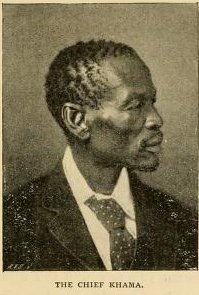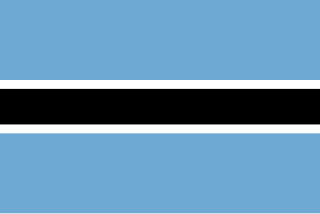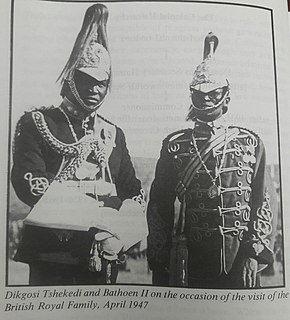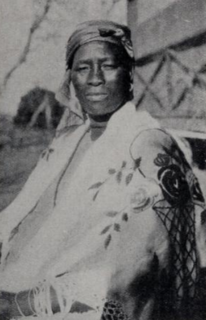Related Research Articles
The Batswana, a term also used to denote all citizens of Botswana, refers to the country's major ethnic group. Prior to European contact, the Batswana lived as herders and farmers under tribal rule.
These lists of cemeteries compile notable cemeteries, mausolea, and other places people are buried worldwide. Reasons for notability include their design, their history, and their interments.

Khama III (1837?–1923), referred to by missionaries as Khama the Good, was the Kgosi of the Bangwato tribe.

The Tswana are a Bantu-speaking ethnic group who are native to Southern Africa. The Tswana language belongs to the Bantu group. Ethnic Tswana made up approximately 85% of the population of Botswana in 2011.

Sir Seretse Goitsebeng Maphiri Khama, GCB, KBE was the first President of Botswana, in office from 1966 to 1980.

The Bechuanaland Protectorate was a protectorate established on 31 March 1885, by the United Kingdom of Great Britain and Ireland in Southern Africa. It became the Republic of Botswana on 30 September 1966.

Serowe is an urban village in Botswana's Central District. A trade and commercial centre, it is Botswana's largest village. Serowe has played an important role in Botswana's history, as capital for the Bamangwato people in the early 20th century and as birthplace of several of Botswana's presidents. More recently it has undergone significant development as the town and Botswana continue to grow.

Palapye is becoming a large town in Botswana, situated about halfway between Francistown and Gaborone. Over the years its position has made it a convenient stopover on one of Southern Africa's principal north–south rail and road routes.
Ruth Williams Khama, Lady Khama was the wife of Botswana's first president Sir Seretse Khama, the Paramount Chief of its Bamangwato tribe. She served as the inaugural First Lady of Botswana from 1966 to 1980.

Central is the largest of Botswana's districts in terms of area and population. It encompasses the traditional homeland of the Bamangwato people. Some of the most politically connected Batswana have come from the Central District, including former President Sir Seretse Khama, former President Festus Mogae, and former President Lt. General Seretse Ian Khama. The district borders the Botswanan districts of Chobe in the north, North-West in the northwest, Ghanzi in the west, Kweneng in southwest, Kgatleng in the south and North-East in the northeast, as well as Zimbabwe also in the northeast and South Africa in the southeast.

Besides referring to the language of the dominant people groups in Botswana, Setswana is the adjective used to describe the rich cultural traditions of the Batswana - whether construed as members of the Setswana ethnic groups or of all citizens of Botswana.[citation needed] the Batswana believe in the rich culture of ubuntu ‘‘People are not individuals, living in a state of independence, but part of a community, living in relationships and interdependence.’ Batswana believe in working together and being united. there are different categories in the Tswana tribe like the Barolong, Bakwena, Bakgatla, Baphuthing, Bataung and Batshweneng. All these tribes believe in different customs but are still guided by the tswana culture and way which makes them have similarities. The languages are still the same but differ slightly from one area to the other or by dialects but they are all regarded as Setswana. The Batswana are based in the Northwest Province of the Republic of South Africa and Botswana,The people in Botswana honour their culture more than those in the Northwest as they are mixed with other tribes and they are slowly but surely losing their culture and adapting in the western culture.

Shoshong is a town in Botswana, formerly the chief settlement of the eastern Bamangwato.
Khama is the name of the royal family of the Bamangwato people of Botswana. As such, it may refer to:

Tshekedi Khama was the regent-king of the Bamangwato tribe in 1926 after the death of Sekgoma II.

Serêtsê Khama Ian Khama is a Motswana politician and former military officer who served as the fourth President of the Republic of Botswana from 1 April 2008 to 1 April 2018. After serving as Commander of the Botswana Defence Force, he entered politics and served as Vice-President of Botswana from 1998 to 2008, then succeeded Festus Mogae as President on 1 April 2008. He won a full term in the 2009 election and was re-elected in October 2014.

The Three Dikgosi Monument is a bronze sculpture located in the Central Business District of Gaborone, Botswana. The statues depict three dikgosi : Khama III of the Bangwato, Sebele I of the Bakwena, and Bathoen I of the Bangwaketse. Events are held at the monument such as the 2008 Miss Independence Botswana. A study conducted between January and August 2007 shows that the monument is the most visited tourist destination in Gaborone.
The Independence Day of Botswana, commonly called Boipuso, is a national holiday observed in Botswana on September 30 of every year. The date celebrates Botswana's Declaration of Independence from the United Kingdom on September 30, 1966.

Semane Setlhoko Khama (1881–1937) was a mohumagadi of the BaNgwato chieftaincy in the Bechuanaland Protectorate. Educated in a missionary school, she became a teacher and upon her marriage to Khama III continued to press for education for the BaNgwato. A proponent of modern medicine, she was influential in bringing modern midwifery to the area. As a devout Christian, she encouraged women's involvement in the church and the Woman's Christian Temperance Union.
References
- ↑ "Botswana Ethnic Groups". Study.com. Retrieved 2020-05-25.
- ↑ Parsons, Neil (25 Feb 1998) "The Abandonment of Phalatswe, 1901–1916", University of Botswana History Department, Retrieved 2 Jan 2006
- ↑ "African dialect uses unexpected sound" (31 Oct 1998) Science News, Retrieved 3 Jan 2006